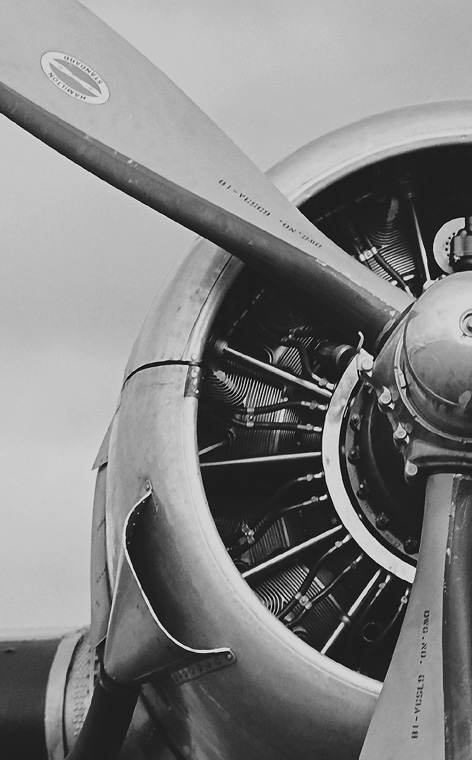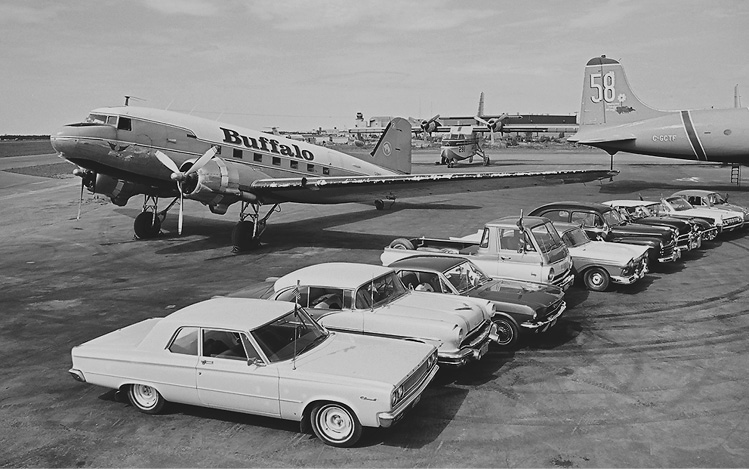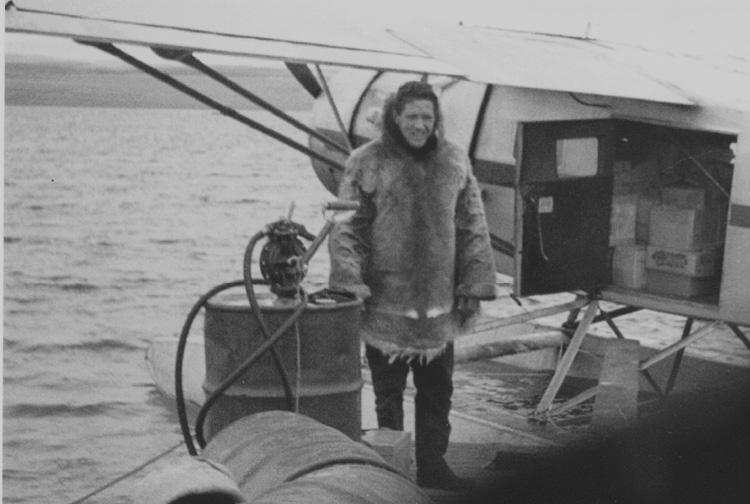

FINDING CHUCK
I wasn’t sure if it was safe to say that Joe was starting to like me, because in all honesty, I had no idea. I was pretty sure he’d got used to the idea of me and was probably okay with running into me at all hours of the day or night, weekdays or weekends. But like me? That was a stretch.
Either way, I wasn’t immune to the ravages of Joe’s mood swings, a development that, if nothing else, at least made me feel like part of the Buffalo family, albeit a transient part. On some days he seemed genuinely pleased to see me. Other times he simply tolerated me. Then there were those uncomfortable instances when he patently couldn’t stand me, when he started grumbling about being a commodity, and about me sucking his brain dry solely for my own personal profit. Those occasions were becoming fewer and farther between, but they still happened. And when they did, they weren’t very pleasant. One Sunday morning, he barked at me: “I could write that goddamn book better than you.”
“Joe, that’s like me saying I could fly a DC-3 better than you,” I replied, holding my turf just a little against the boss.
He didn’t give in, though I could tell I’d made my point. “I could write it better because I was there,” he said, softened somewhat.
Thankfully, Joe was not immune to sharing friendlier moments with me too. And on those rare occasions when he did open up, I felt blessed for the glimpse I got into what has been a truly remarkable life. They also gave me a little more insight into what makes Joe McBryan tick. And as much of a man’s man as he is, I think Joe harbours a fair bit of fear. When it comes to the book, he fears two things: that I will not tell his story accurately, and that people will not believe a word of it.
I can understand why. Some of his stories are so outlandish that most people would shake their heads. Sure, Joe embellishes his tales a bit, but as an old cowboy friend of mine used to say, “Don’t ever let the truth get in the way of a good story!” Truth or not, when Joe is on a storytelling roll, he is captivating.
A couple of the Ice Pilots crew and I were sitting around in the Buffalo Airways kitchen one Saturday morning, and Joe was regaling us with a tale of how one of his first planes—his prized Noorduyn Norseman—was wrecked in August 1970. “If you put it on film or in a book,” he said as he washed the dishes, “it would be straight bullshit. Nobody would ever believe it.”
So here goes. Joe wasn’t flying the Norseman at the time; one of the pilots working for him was shuttling nine aboriginal firefighters from a lakeside bush camp to various hot spots in the area. On takeoff one morning, the pilot made the mistake of switching his fuel selector to a dead tank. The engine quit shortly after that, requiring the pilot to circle back around and land on the lake. Lacking sufficient power and speed, the pilot couldn’t round out the plane enough and dug the floats into the water, flipping the Norseman upside down in the lake, where she floated perfectly, cockpit submerged, the floats keeping her from sinking.
As it turns out, the aboriginals on board were not particularly strong swimmers, Joe told us. “So the pilot’s stuck in the cockpit, but nobody will go help him because they can’t swim. And they’re all yelling ‘C’mon Bob! C’mon Bob!’ and firing life jackets at him.” The pilot finally extricated himself from the cockpit, a bit bloodied from the impact, but otherwise unhurt.
With little other choice, the passengers decided to swim for shore, but not before shedding their clothes. “But before they do, they find one of the first aid kits floating in the water, and all decide to wrap some gauze bandage around their heads, in case they get hurt. So now they’re out there naked, with only a gauze band wrapped around their heads.”
Luckily, the Norseman’s pilot—a gentleman by the name of Bob Gauchie—was able to convince his passengers that swimming to shore might not be the most advisable course of action, given that there was no imminent danger and the plane would float indefinitely. Instead, the ten men set to the weighty task of paddling the plane to shore. “He got them to all kneel down on the floats and start paddling the airplane toward the shore,” Joe said. “There’s a current in that lake, but it’s the only thing you can do if you’re upside down.”
Meanwhile, the firefighting camp was now abuzz with activity. Among those on shore was a rookie helicopter pilot with his Bell 47 chopper, which had been equipped with floats for water landings. After witnessing the Norseman crash, the helicopter pilot jumped into action, grabbing his engineer and hopping in the chopper.
“But instead of landing beside the airplane,” Joe said, “he hovers over it and looks at everything going on underneath him. Well, the guys on the floats all panic and grab the skids [the ski-like metal strips that helicopters land on] and start climbing on. Well, the helicopter flips over too, and ends up upside down in the water too!” Now everybody is swearing at everybody else—a complete mess.
For act three of this comedy of errors, enter the remaining firefighters, who were standing on shore watching both the plane and the helicopter crash into the water. With no boats at their behest, they were forced to turn to their collective ingenuity to mount a rescue effort. They strung together a series of metal fuel kegs and assembled a makeshift raft, paddling feverishly out to the crash site. “They didn’t know how many people were dead or maimed or hurt,” Joe said.
Apparently the firefighters were not particularly adept sailors, though, because the raft came apart halfway to their destination. The knots had untied and the ropes fallen off. “So now,” Joe said almost in hysterics, “each guy is holding onto a fuel drum. They got the whole fucking camp out there in the lake floundering around and screaming and hollering and blaming each other!”
At around the same time, Joe was flying back from the High Arctic community of Cambridge Bay, listening intently to all the chatter on the radio about a Norseman and a helicopter crashing. “I thought they had crashed in mid-air,” he said.
By the time Joe returned to Fort Smith to refuel, he was still no clearer on what had happened at the crash site. All he knew was that people were calling for ambulances to be readied for those arriving from the crash site. Of course, Joe thought the worst.
He was mistaken. The reason ambulances were needed, Joe said, was for their blankets, which would help warm the drenched survivors in the cool night air. Nevertheless, the scene was nothing short of unbelievable to Joe’s eyes. “They all had these grey blankets wrapped around them like capes and white bandages wrapped like bandanas around their heads.”
Incredibly, nobody was hurt. “When I got out there the next morning and looked at the situation, I was convinced this was a straight bullshit story, bar talk,” Joe said. “And you know what? We never, ever told that story much because it was just too stupid to believe. The only people who believe that story are the forestry guys, the helicopter pilot, my crew, and the nine Indians from Fort Rez who were down on their hands and knees trying to paddle because they couldn’t swim.”
If there’s a shred of truth to Joe’s story, it helps show that even the best northern bush pilots find themselves in the occasional sticky situation. Call it an occupational hazard. Bob Gauchie, who was flying the Norseman when it flipped in the lake, knows that all too well. Though Gauchie’s legacy as a bush pilot reaches far across the North, he is most remembered for the fifty-eight days he survived in a downed bush plane in the Arctic wilderness in February and March of 1967.
On February 2, 1967, Gauchie was making his way back to Yellowknife from Cambridge Bay, where he had dropped off a group of engineers. It was a bright, clear day, but brutally cold. At one point, the cockpit thermometer bottomed out at –58°C (–72°F). When Gauchie was about 350 kilometres (220 miles) northeast of Yellowknife, the weather deteriorated to the point that he was forced to land his ski plane and wait it out. He set out again the next day, but he got disoriented in a whiteout and his compass failed. With no fuel left, Gauchie was forced to land on Samandre Lake, near the eastern shores of Great Bear Lake. He was about 300 kilometres (185 miles) off course. He was horrified to find that neither his radio nor his two emergency beacons were working.
Luckily, Gauchie had several sleeping bags in the plane, five days of rations for five people, and eighteen kilograms (forty pounds) of arctic char he was bringing home for his wife. With little else to do, Gauchie bundled up—and waited. The temperature sat near –60°C (–76°F) for two weeks.
Time passed slowly. The official search was called off. And still Gauchie waited.
On the twenty-fifth day of this living hell, Gauchie heard a plane pass overhead, and fired a flare. Nothing.
Over the next several weeks, more aircraft passed overhead. None noticed his plane, an indiscernible speck on the vast canvas of snow below.
Other than the wolves that kept him constant company, Gauchie passed the time cold and alone. He had eaten so much char that he could no longer stand the taste of it, but it was the only thing keeping him alive.
Finally, after Gauchie had spent fifty-eight days trapped on the lake, a plane passed overhead. Gauchie fired off two flares. The plane turned around.
When the pilots landed on the lake, Gauchie was ready for them. He was emaciated and had a long, unkempt beard, but had not lost his sense of style. He stood there as they approached, a blue suitcase in his hand. When they got out of their plane, the first thing he said to them was “Have you got room for a passenger?”
He has not eaten fish since.

Two of Joe McBryan’s greatest passions are vintage cars and vintage planes. The DC–3 in this photo—”Summer Wages,” named for a song by Canadian folksinger Ian Tyson—is one of the most famous in the Buffalo fleet. It flew in the eleventh wave of the invasion of Normandy in World War II.
Joe must have started feeling comfortable with me that morning, because shortly after telling his Norseman story, he invited me into his office. I’d been in there before—on my first day at Buffalo, when Mikey brought me in to show me Joe’s collection of aviation books (“Into the mind of chaos,” he had said then as he opened the door), but I’d never had the chance to get a feel for the place as a guest of Joe’s. Until now, that is.
The office is a testimony to Joe’s life and passions: aviation, his family, and vintage automobiles. In fact, it’s more like a museum, or perhaps an antique shop, than an office. It is dominated by an Indian Chief Centennial motorcycle sitting beside Joe’s desk. A neon Route 66 sign hangs overhead.
Photographs of classic cars from the 1940s, 1950s, and 1960s—mostly Fords and Mercurys, Joe’s favourites—pepper the walls, and die-cast models of planes and cars fight for space on the shelves with hundreds of aviation books and manuals of every description. A beautiful wooden propeller sits in another corner of the room, festooned with pairs of intricately embroidered moosehide mitts and slippers.
An old Streamliner toboggan—the kind with wooden slats and red metal runners—hangs from the ceiling in a corner of the room. Underneath it are cases filled with old aviation instruments, leather pilot’s goggles, the yoke of a long-forgotten plane. My search revealed old magazines of collectible cars and instrument panels salvaged from the cockpits of obsolete planes. The cockpit door from an old aircraft is mounted directly onto one of the office’s doors.

A bushman to the end, Chuck McAvoy poses in front of his beloved Fairchild 82. Ironically, the plane was the main competitor for the Noorduyn Norseman, a plane Buffalo Joe continues to fly to this day.
One of the photographs on the wall, its edges beginning to yellow with the passage of time, is of the Grade 9 class from the Federal Day School, Hay River, Northwest Territories, spring 1960: Joe’s class. Picking out the Buffalo patriarch is not the easiest task, but after scanning the faces for a while I settled on a young man with a heavy pompadour, the coif Joe wears to this day. Another photograph sees a much younger Joe—perhaps eight or nine years old—feeding a magnificent sled dog.
All of it speaks to that elusive, soft side of Joe McBryan I had been so longing to find. Just when I was beginning to think that Joe might never open up to me, here I was sharing time and space with some of his most prized possessions. The door of the silver Fox Moth that was Joe’s playhouse as a child is also here, the words “Mcavoy Diamond Drilling and Development Company, Ltd. Yellowknife, NWT” still clearly visible in red block lettering.
Among all this, the thousands of bits and pieces that collectively form the backdrop of Joe McBryan’s life, there is one object that says more about Joe than any other. It’s a small, yellowing, canvas-covered case, whose leather corners and leather handle are drying with age. Locked to its handle is an old silver pocket watch, and attached to the pocket watch chain is a nondescript plastic sleeve. Inside that sleeve is a carefully preserved bit of fabric only 10 centimetres long by 2.5 centimetres wide (4 inches by 1 inch). The canvas is the exact same shade of green as the planes in the Buffalo fleet. “Buffalo green,” they call it in Yellowknife.
Joe, it seems, was not the first one to use the colour on an aircraft. The fabric is a piece of canvas from Chuck McAvoy’s Fairchild 82 bush plane, which disappeared in 1964. Joe would spend the next thirty-nine years searching for his mentor.
While Joe was growing up at the Gordon Lake Mining Camp in the 1950s, Chuck McAvoy was developing his reputation as a living legend, a fearless bush pilot who thought nothing of braving the toughest conditions the North could throw at him to shuttle prospectors, adventurers, and loners to the far-flung reaches of the Arctic. Chuck was everything young Joe wanted to be: strong, brave, independent, and very capable in the pilot’s seat.
Chuck took Joe under his wing and treated him like a little brother. On slow days at Gordon Lake, Chuck threw Joe in his single-engine Cessna and taught him the care and control of an aircraft. Under Chuck’s tutelage, Joe learned the fine art of bush flying: how to assess the weather, land on a frozen lake, read the subtle clues offered by the land, and find your way out to the middle of nowhere—and back home again. To Joe, Chuck was larger than life itself. So when Chuck told Joe that he was going to make a hell of a bush pilot one day, Joe took it to heart.
In Chuck, Joe found a mentor worthy of emulation. In his years of bush flying, McAvoy had developed a reputation as the bad boy of northern skies, a standing he rightly deserved. He would regularly take off and land in the dark, a practice verboten by Transport Canada. He was as renowned for his daring aerial stunts as for slugging it out in the Gold Range bar.
Chuck was much more than a rebel. He participated in almost every search-and-rescue operation mounted in the North and had an uncanny knack for bringing home lost souls well before anyone else—even the air force. In May 1960, Chuck came back with two survivors who had spent almost three weeks stranded in a remote section of the Northwest Territories’ Nahanni Valley. Nobody else had been able to find them.
Given Chuck’s prowess in the cockpit, you can understand Joe’s shock when—on a warm spring day in 1964 with a brand new commercial pilot’s licence in hand—Joe was told that Chuck’s plane had disappeared. Joe had just returned to his home in Hay River, and his first job was going to be flying Chuck’s Fairchild 82. “But when I got to town, they said ‘Chuck’s missing,’ ” Joe recalls.
It was June 9, 1964, the day thirty-one-year old Chuck was supposed to have taken two American geologists—Albert Kunes and Doug Torp—to a remote lake some 600 kilometres (370 miles) northeast of Yellowknife in the canvas-skinned single-engine float plane. They never arrived.
Their disappearance sparked a full-scale search for much of the next two months. In addition to a host of private pilots—all of whom were acquainted with the dynamic personality of Chuck McAvoy—the Royal Canadian Air Force (RCAF) offered search-and-rescue crews from Winnipeg, Vancouver, Nanaimo, and Cold Lake, Alberta, to aid in the hunt. In total, they flew almost 1,300 hours over some 600,000 square kilometres (231,500 square miles) of lonely Barrenlands searching for the downed plane, to no avail.
The mystery of Chuck’s disappearance was deepened by the fact that search conditions were ideal throughout that entire summer. The sun shone almost twenty-four hours a day, and the skies proved clear and bright most days. Yet despite hundreds of sets of eyes and as much manpower as the air force could dedicate, there was absolutely no sign of the Fairchild or the three men. The RCAF had no choice but to conclude that either the men had died in an inflight fire, or they lay at the bottom of one of the thousands of unnamed lakes that dot the tundra. Either way, the official search was called off.
Like many other Yellowknifers, Joe refused to accept Chuck’s disappearance without a fight. For months to come, pilots of all stripes donated their planes, time, and money to continue the search for the Fairchild. Each time, a disappointed pilot would return to Yellowknife with the same report: no sign of Chuck.
Others ultimately grew accustomed to the notion that they would never see Chuck or his plane again, but Joe was not so easily convinced. For the next thirty-nine years, one month, and twenty-six days, Joe made the search for Chuck his personal holy grail. He spent countless hours on solo flights across the lonely Barrenlands looking for his friend and mentor, and never failed to remind other pilots to keep their eyes peeled for Chuck.
By some cruel twist of fate, it was not Joe’s lot to solve the mystery of his old friend. That distinction fell into the lap of a twenty-four-year-old helicopter pilot from rural Saskatchewan named Curtis Constable. On August 3, 2003, Constable was transporting a crew of four young geologists back to their camp near Lupin Lake, about 300 kilometres (185 miles) southeast of the Arctic Ocean community of Kugluktuk, flying a route they had traversed many times before that summer. It was a well-travelled route that led to the Lupin Mine. Something caught Constable’s eye sixty metres (two hundred feet) below: a glint of sun off a piece of metal on the tundra.
Constable landed the helicopter to investigate further. As he walked closer, he became the first human being in thirty-nine years to lay eyes on the Fairchild, lying serenely camouflaged atop a pile of sun-bleached rocks.
“There’s Chuck’s airplane,” Joe said to me as we lingered over a picture of the wreckage, a nondescript metal frame spread gently over a small patch of tundra. “Try finding that in the bush.”
It wasn’t long before the men realized they had stumbled upon something important. Human remains and camp equipment were strewn about the area. Constable’s most important discovery was Chuck’s wallet, its contents still largely intact despite the passage of time and the ravages of weather. Among the items he found inside was a membership card for the Flamingo Las Vegas. Yup, that was Chuck all right.
Joe was relieved that the mystery of Chuck’s disappearance had been solved, but the irony of the discovery was not lost on him. “I still can’t believe that little prick found him,” he said. “I looked for him for thirty-nine years. I was looking for Chuck longer than that kid was alive.” The discovery made headlines across Canada.
Before the discovery, many theories had floated around about what had happened that fateful day back in 1964: a makeshift repair job Chuck had performed earlier on a wheel caused the crash; Chuck got lost and ran out of fuel; the plane crashed through the ice.
To the contrary, Joe says the state of the plane shows that it was a controlled crash in level flight, as if it were taking off or landing. In Joe’s mind, an engine failure sent the three men to their untimely demise. Still, the fact that the fuselage and wings were intact shows that Chuck flew the plane to the very end, trying to bring it down for a landing where no plane had ever landed before. In fact, other than fire damage to the engine compartment and cockpit, the rusting frame still looked very much like an airplane.
In classic McBryan style, Joe was not satisfied with merely learning the details of the crash. He needed closure, and he knew others were feeling the same way too. So Joe organized a trip to the crash site for McAvoy’s siblings and the geologists’ families, some of whom came from as far away as New Jersey. It was a moving experience for everybody, Joe included.
Yet not everyone was quite as touched when news of Chuck’s discovery reached the outside world, particularly Jim McAvoy, who was seventy-two at the time. For Jim, Chuck’s death had been a foregone conclusion. It was just a matter of time. “He was a lousy pilot,” Jim said of his younger brother in a 2003 National Post article. “He didn’t have much experience and he would try to outdo me all the time and he wasn’t capable of it.”
“I don’t feel anything,” Jim said of the discovery of his brother’s plane, his lack of emotion likely the result of years of disagreement between the two about how best to run their charter airline. “He and I didn’t get along too good. That was a long time ago.”
Although he didn’t mention them, Joe’s feelings on the subject are vastly different. To this day, Joe keeps a scrapbook in his office that is dedicated solely to the search for and discovery of Chuck’s Fairchild 82. The heavy binder is stuffed with newspaper and magazine clippings, photographs, original Royal Canadian Air Force search-and-rescue reports. We pored over its pages, the silence heavy between us. He pulled a photograph from a protective plastic sleeve and laid it on his desk for me to see. It was the scene he witnessed back in 2003 when he landed at the crash site for the first time.
“This is the whole scene,” he said softly. His fingers traced the image and came to rest on a skeleton lying near the plane. “That’s Chuck there.”
It was Joe, of course, who brought Chuck—and his plane—home. This time it was on a DC-3.
Fred Carmichael, NWT’s First Aboriginal Bush Pilot
Max Ward: The Entrepreneur Bush Pilot



